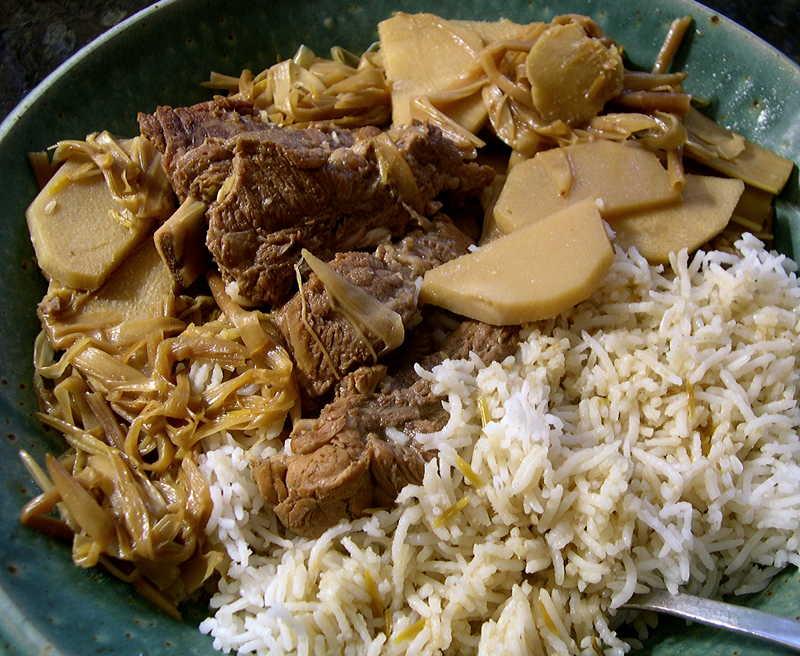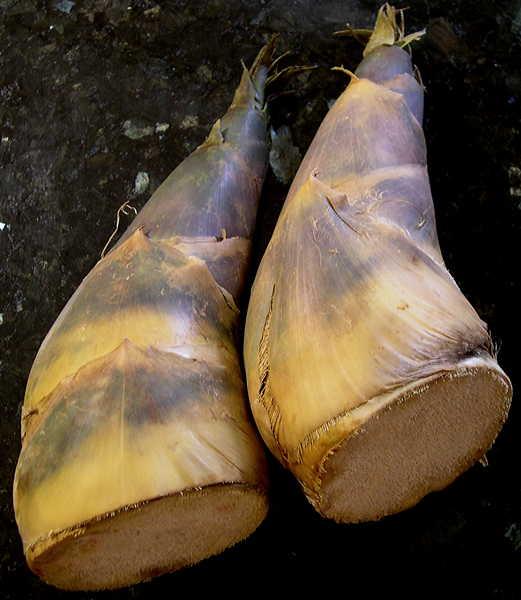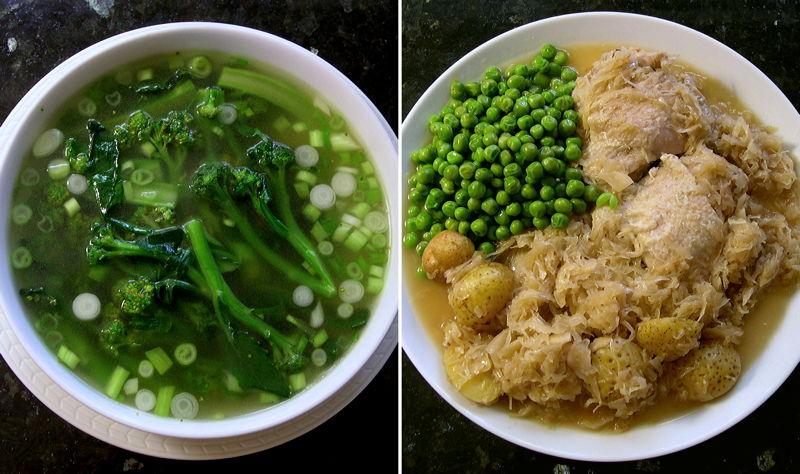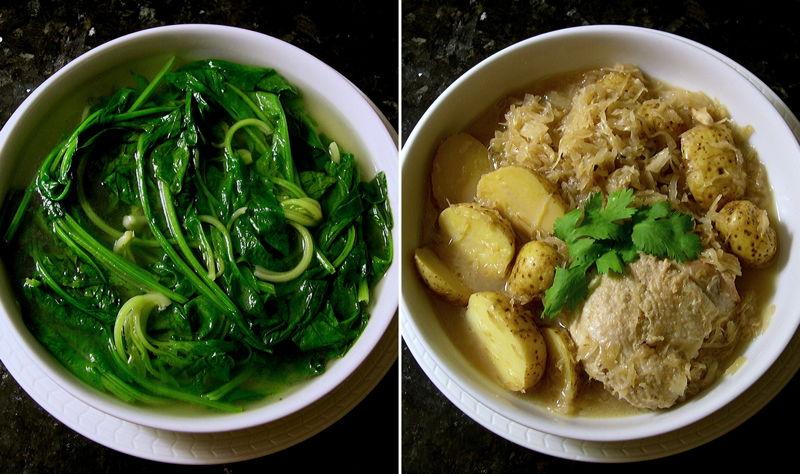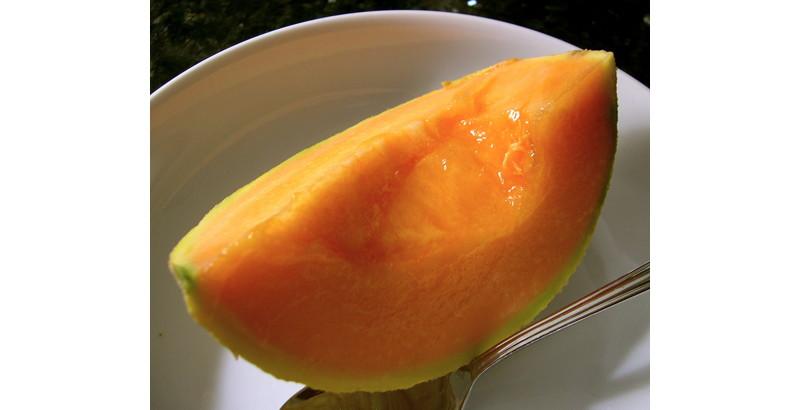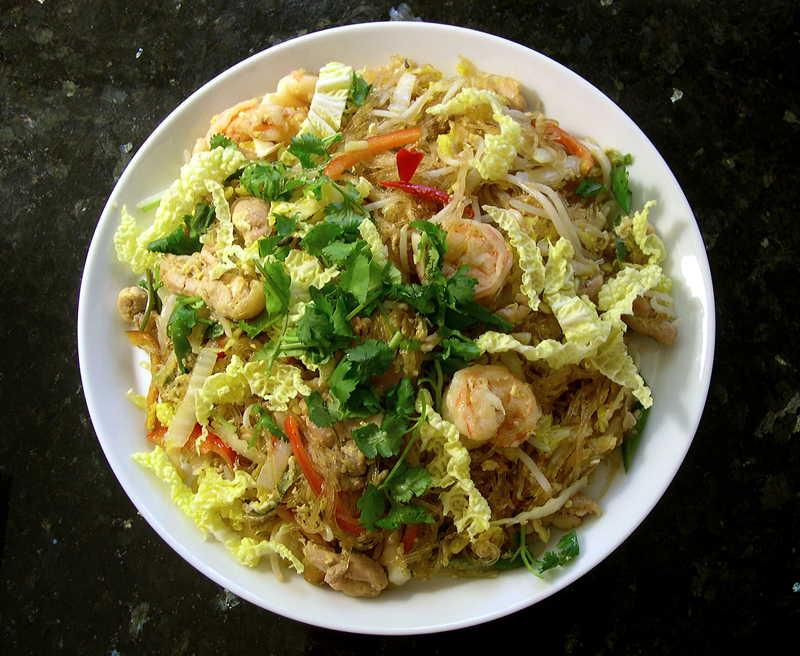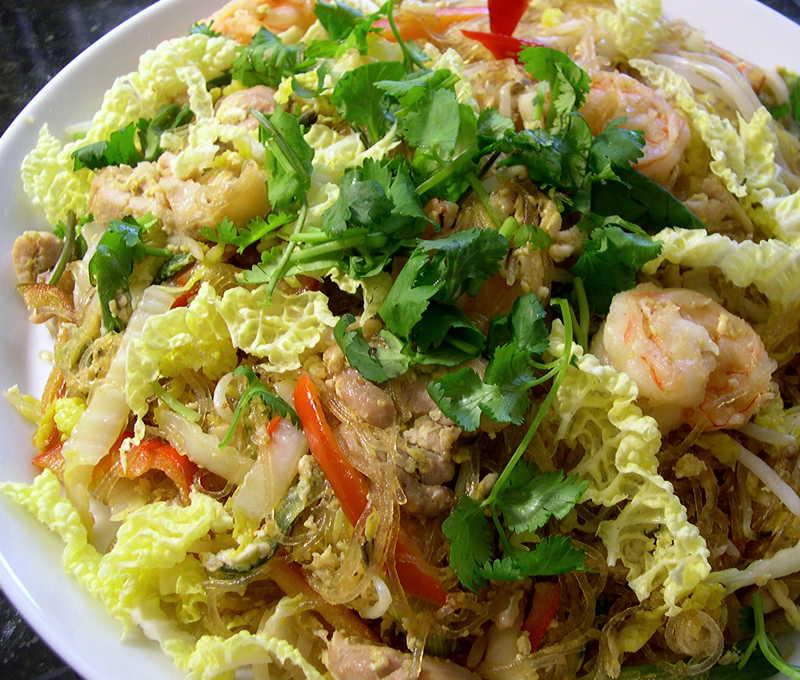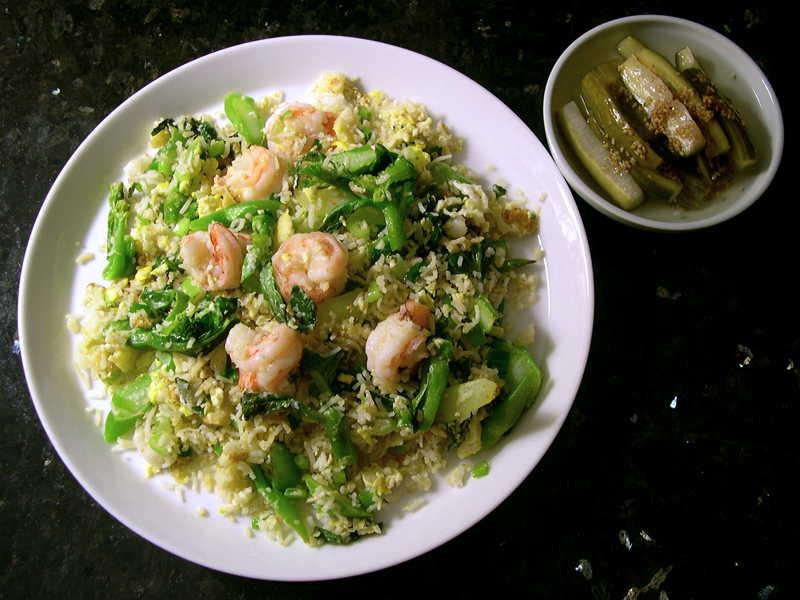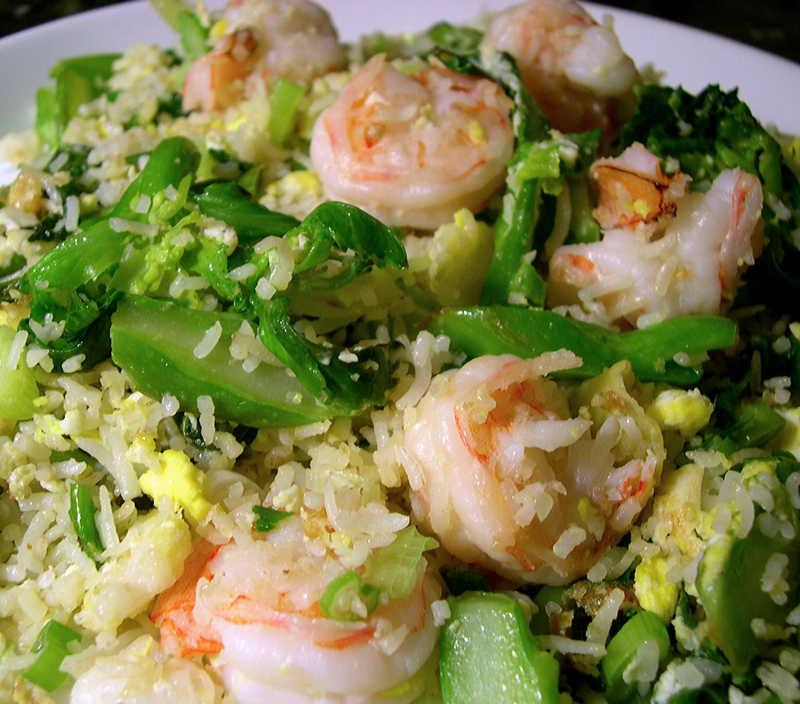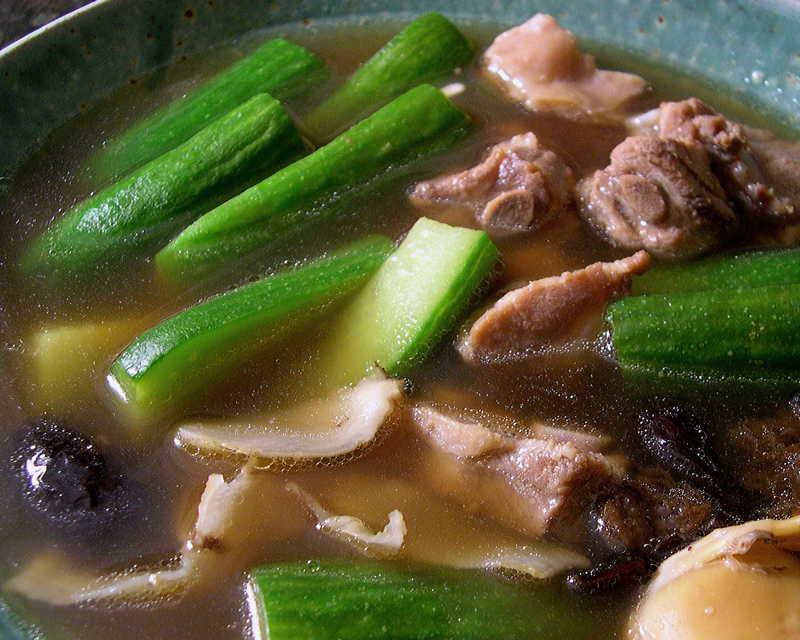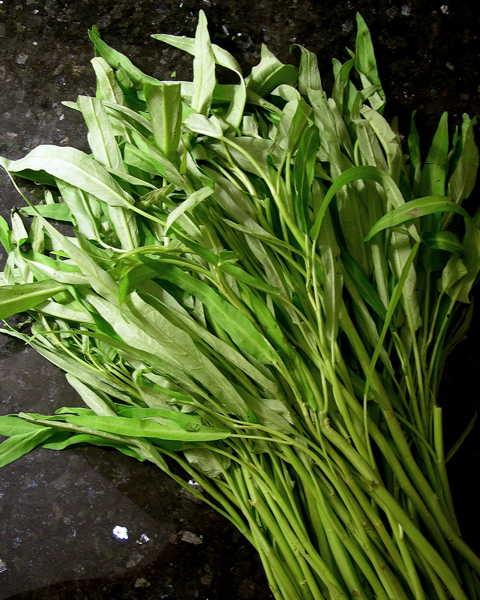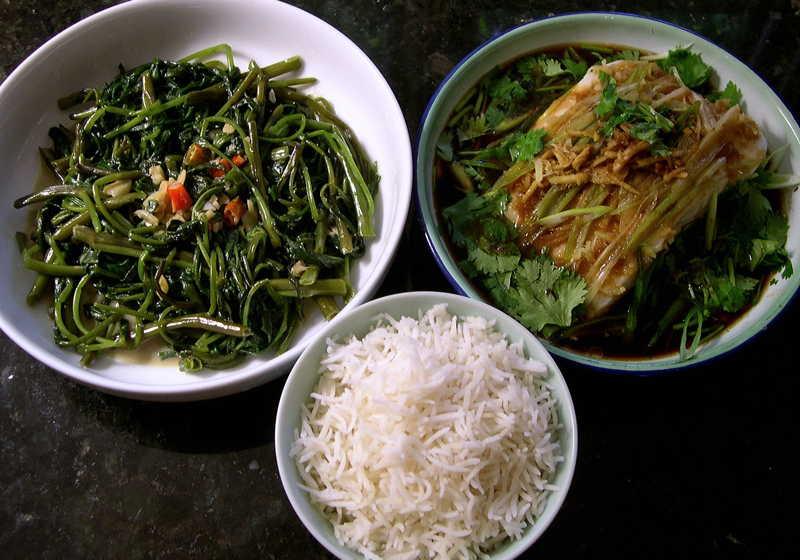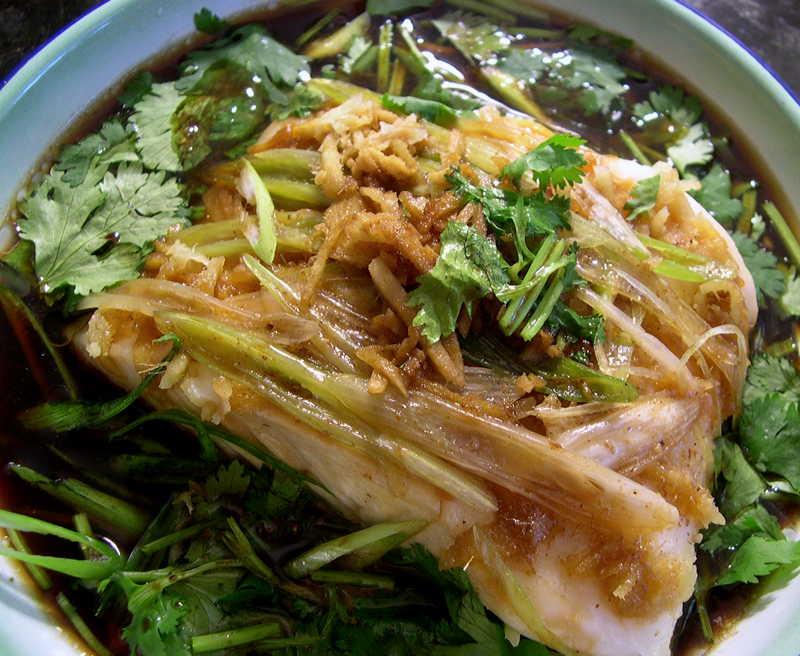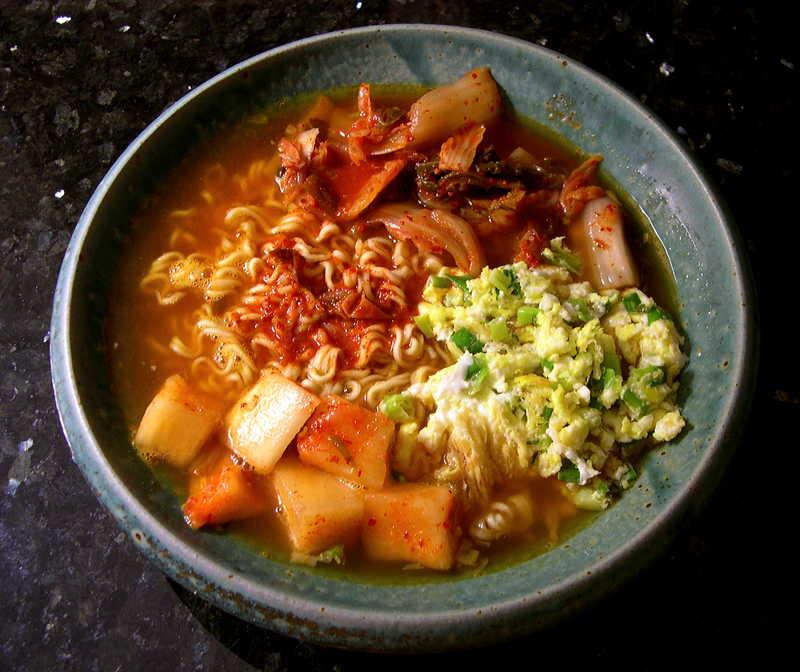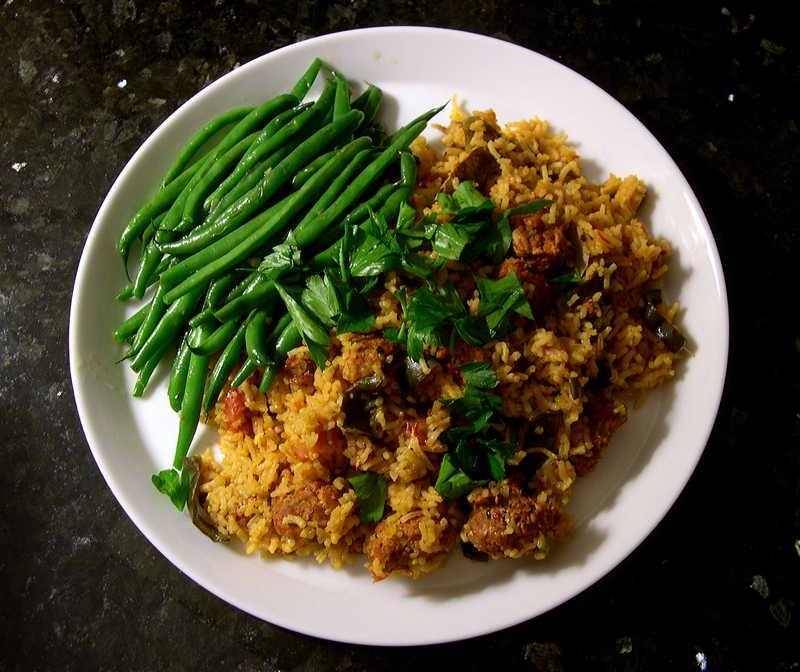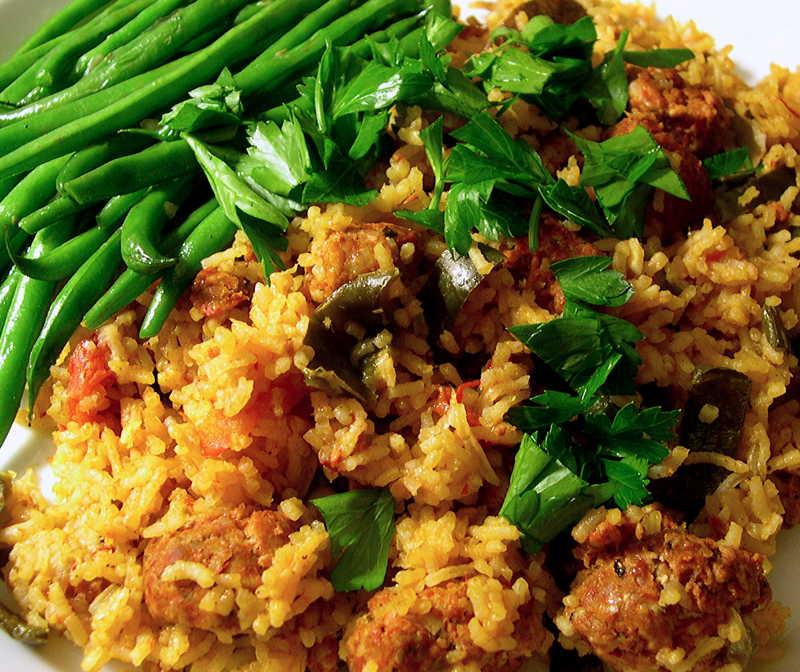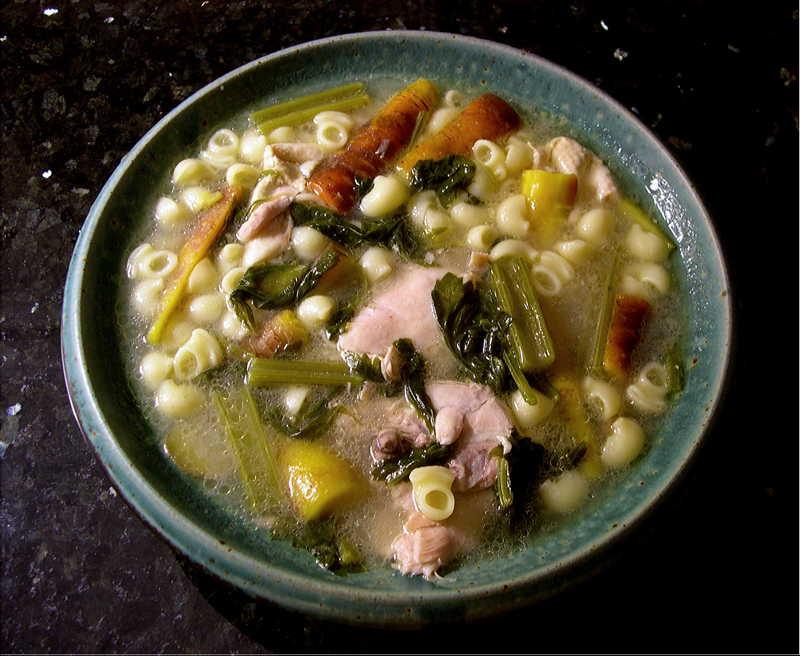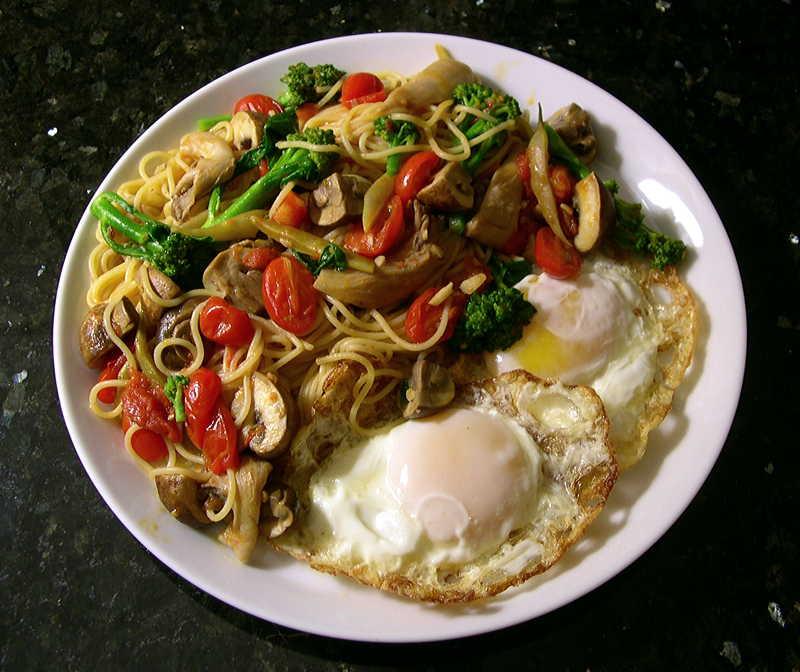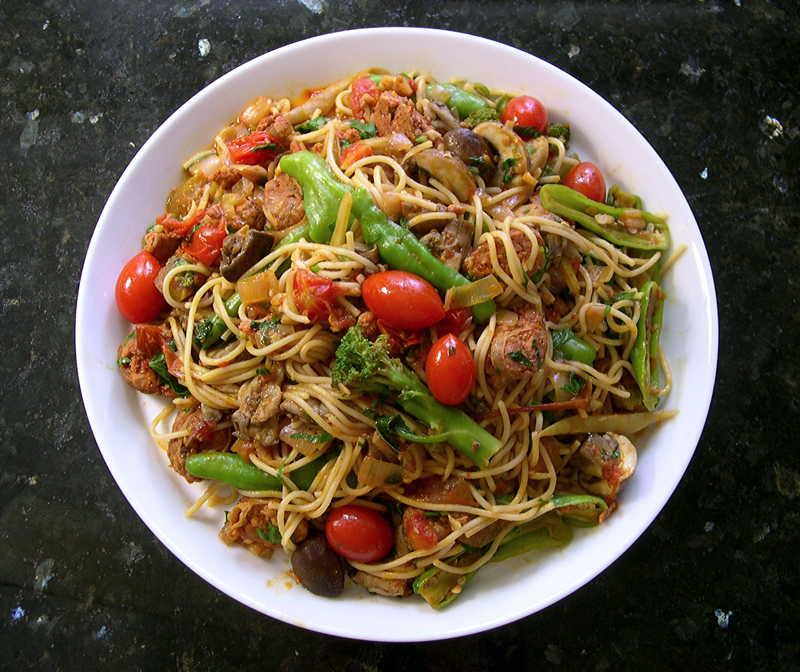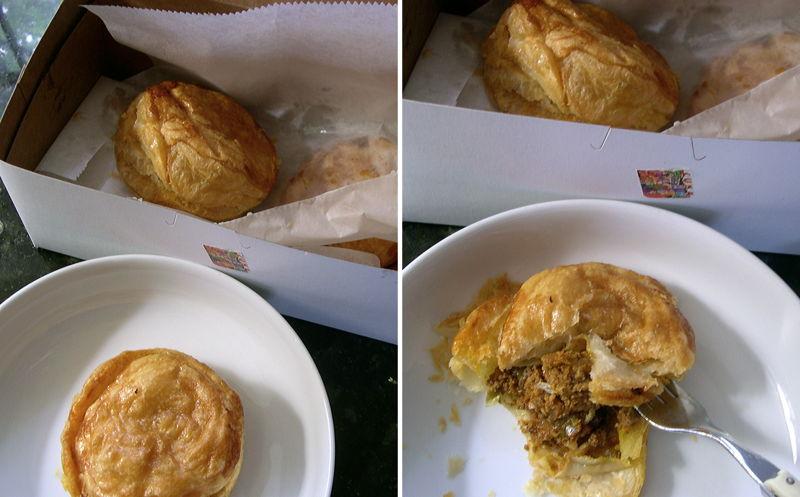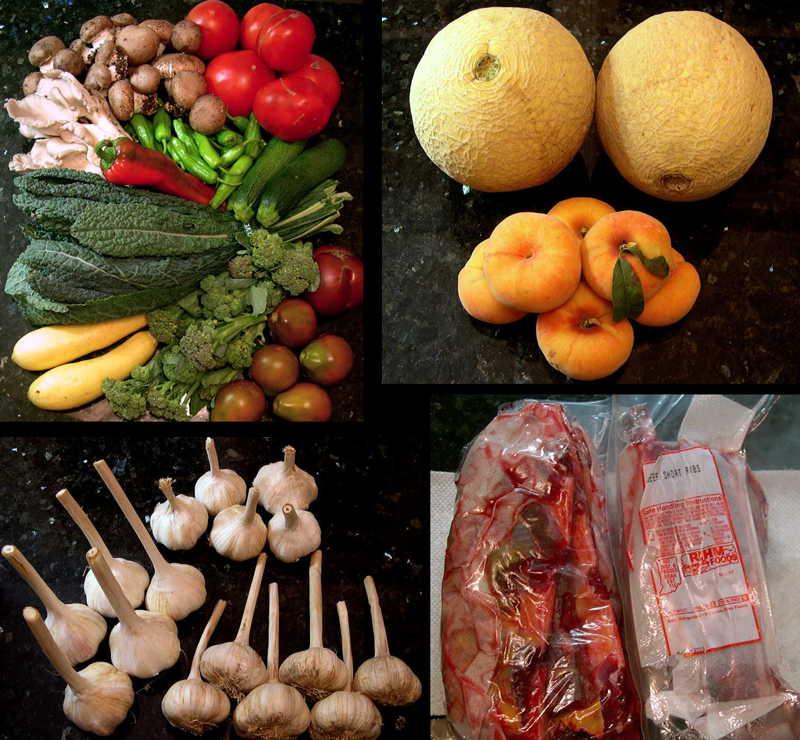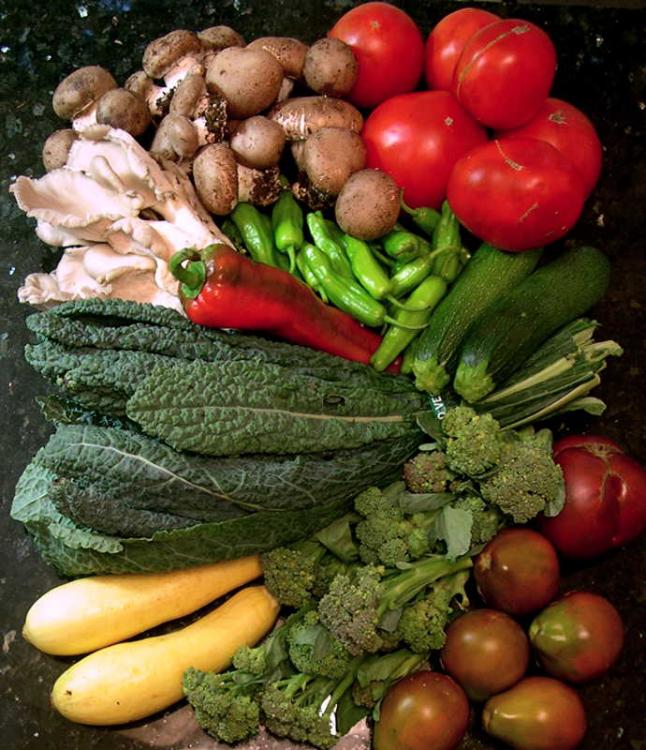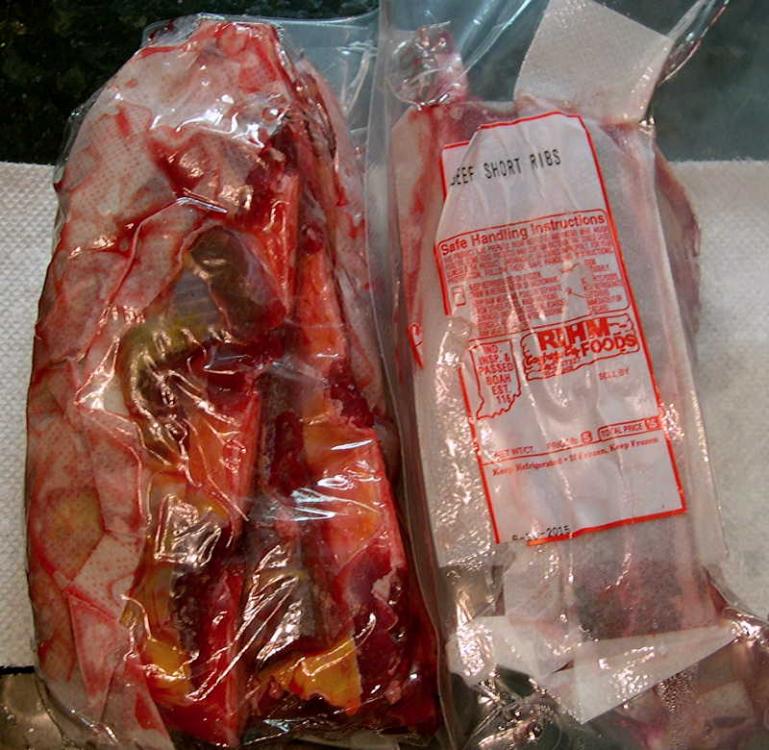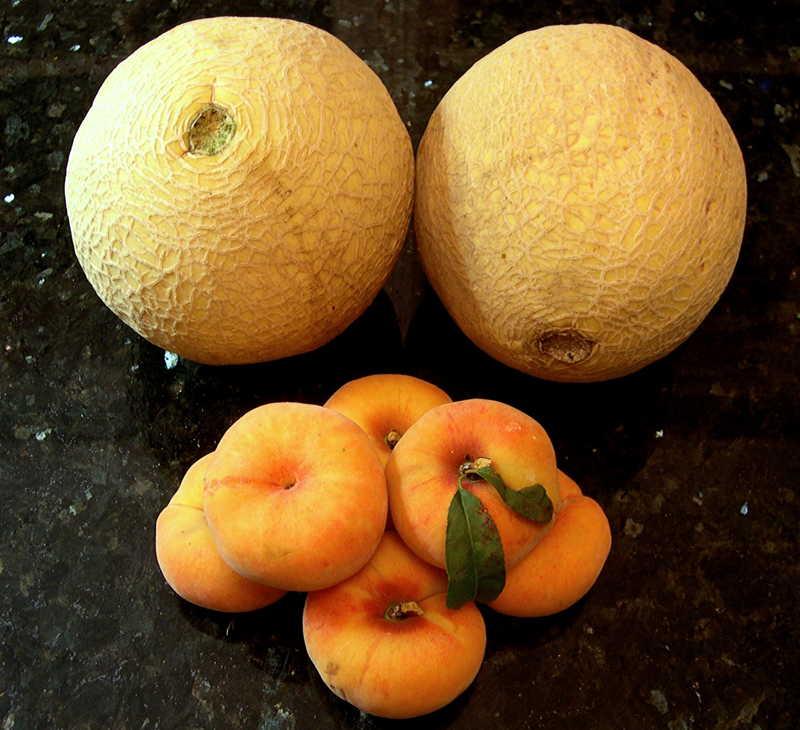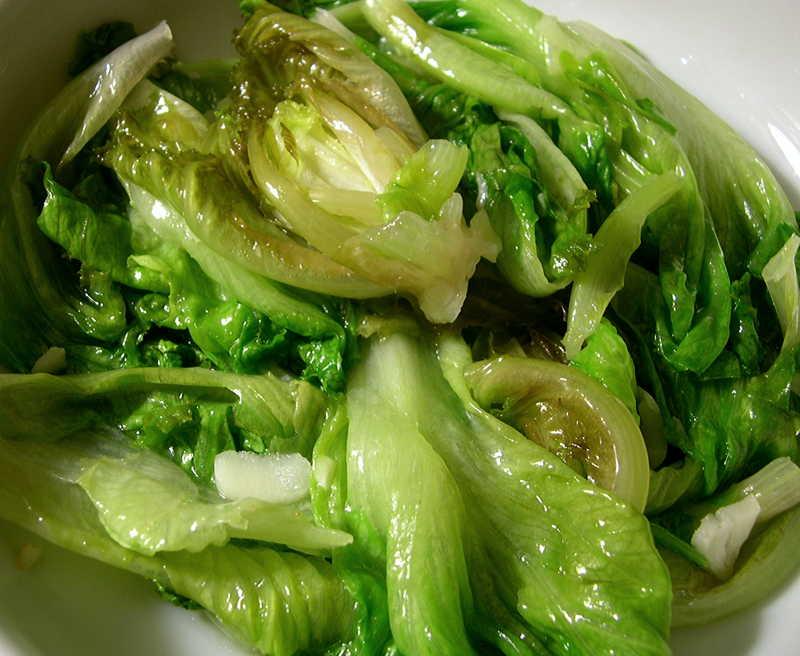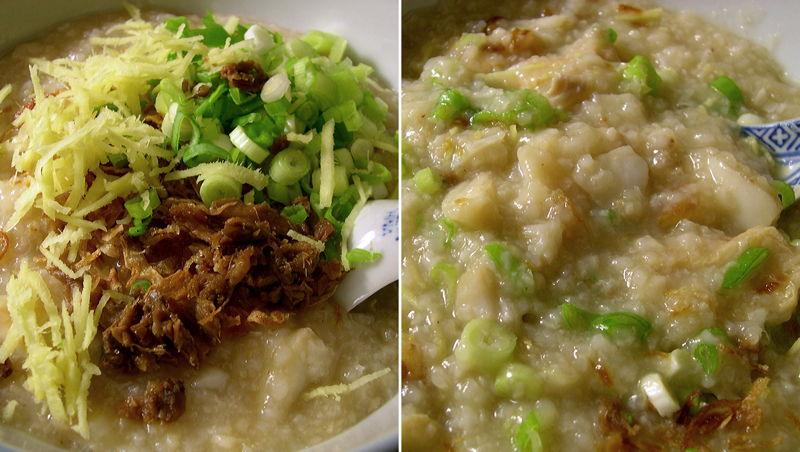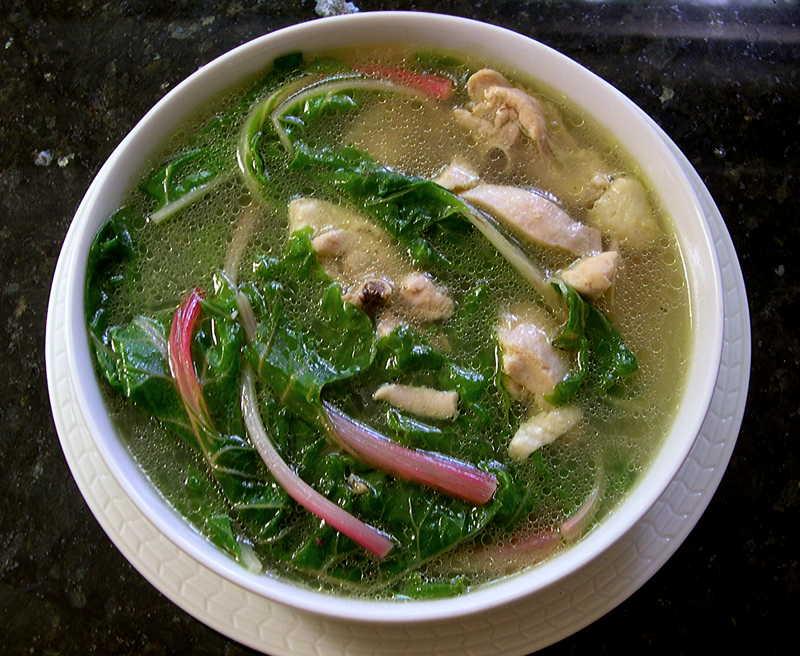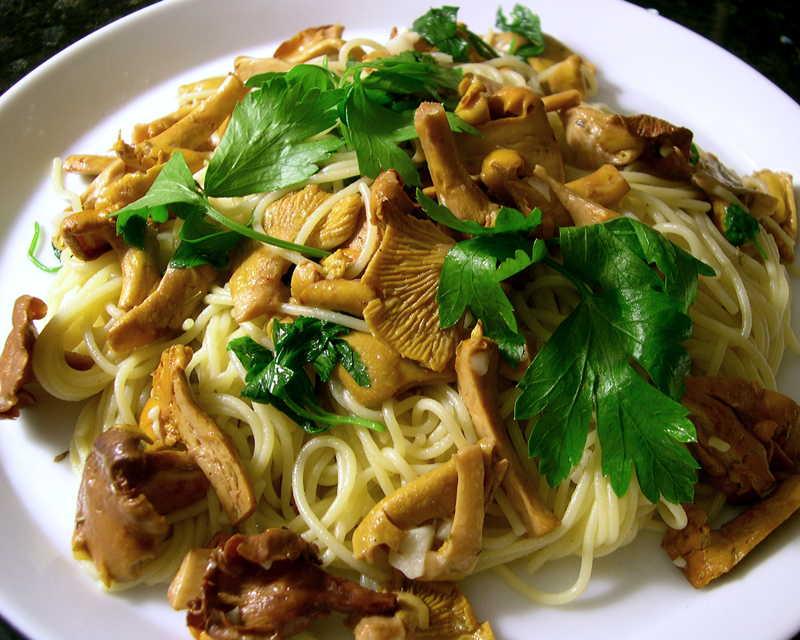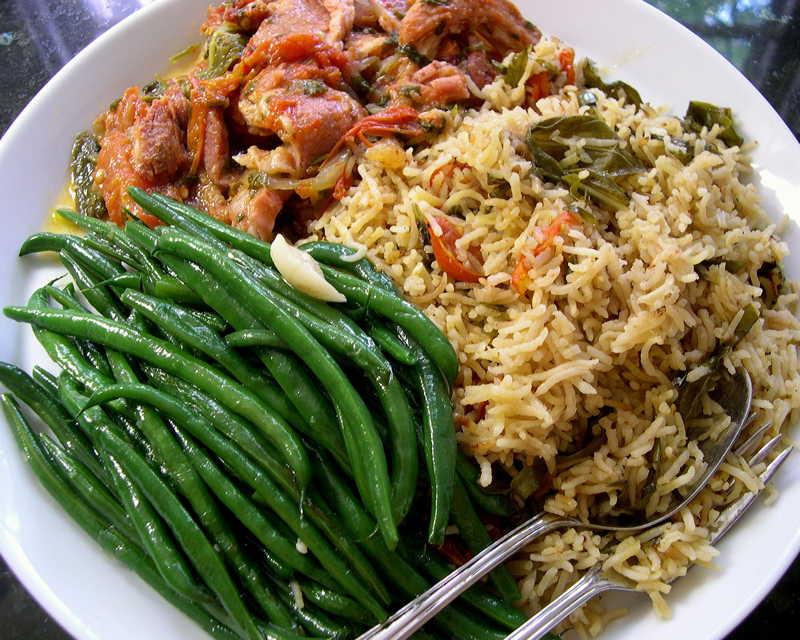-
Posts
3,810 -
Joined
-
Last visited
Content Type
Profiles
Forums
Store
Help Articles
Everything posted by huiray
-
Pork ribs (baby back) braised w/ spring bamboo shoots, dried lily flower buds, garlic,ginger, fermented tofu (this one). Rice. Plus oriental spinach in broth (not pictured). Bamboo shoots.
-
Chicken thighs, Kühne Sauerkraut (pan-browned), new Yukon Golds, garlic. Earlier – with broccoli & scallions in chicken broth; plus fresh peas. Later – with Oriental Spinach in chicken broth. Much later – a quarter of a mini cantaloupe. (the spoon seen is a teaspoon)
-
Pad Woon Sen chez huiray, today's version. Stuff that went in included (not in order of addition or cooking): Shrimp, chicken, glass noodles, wong nga pak (Napa cabbage), mung bean sprouts, scallions, garlic, coriander leaves, Carmela sweet red pepper, fish sauce, oyster sauce, double-fermented soy sauce, water, sugar (I used hon-mirin), eggs. And oil, of course.
-
One does not need the fermented tofu to make this. If one uses it, though, the more traditional type is the one called 南腐乳 ("southern fermented bean curd") or simply 南乳, which is more common in Fujian/Southern China and, through the diaspora, in SE Asia. But the one you have is fine too. Both fall into the general category of "red fermented tofu". They have a slightly different taste from the more-often-found "white" ones. Here's a couple of recipes for making it without the fermented tofu - here and here. "Bakkwa" is the Hokkien for it. I know it as "long yook" (or "long yuk") which is the Cantonese for it. The distinctive smokiness from grilling it over charcoal is a key component of the stuff in a traditional sense, and the best ones are done in that manner. I have fond memories of walking down certain streets when growing up and gazing at (and smelling) all the long yook being grilled on these big grates over, yes, big spreads of charcoal embers in shops (kopitiam-type) basically side-by-side. Long yook was also made not with minced pork, but with shredded fatty pork - so the sheets of it that were formed still visibly had strands of pork tissue plus the fat in it, as opposed to the even "minced" look that is the result of the recipes above and the Youtube recipe. Some of the stuff from the best stores in the place I grew up in did it this way. Grilled over charcoal, of course. :-)
-
Fried rice. Hot oil + hot pan, sliced ginger, trimmed sliced kai-lan hearts & stems, sea salt, push stuff to the sides then a couple of farm-fresh eggs & scramble in situ in the center, add white rice while eggs are not yet set, toss & mix around; push stuff to the sides & add more oil then deveined deshelled wild-caught Atlantic shrimp, flip shrimp over once; mix everything back together, add chopped scallions & scramble & toss. Heat turned off, covered for a minute. Served. Pickled Persian cucumbers, scallions, sesame seeds. (Done this way)
-
scubadoo97 and Ann_T, thanks for the compliment. --------------------------------------------- A meal in two stages. Cucumber soup. Short-cut pork spare ribs, parboiled & washed. Then: water, the cleaned riblets, dried Chinese (Shanxi) red jujubes, dried (salted) cuttlefish, sliced dried Angular Solomon's Seal rhizome, simmer; then Persian cucumbers sliced into sticks, seasoning adjusted, simmer a bit more till done. Cantonese-style stir-fried Ong Choy. Peanut oil, very hot pan, garlic, hot red chillies, fermented wet bean curd, some of the bean curd liquid/brine, ong choy (kangkong, "Morning Glory", etc; Ipomoea aquatica) (trimmed, washed, briefly pre-blanched), toss. Cantonese-style steamed halibut. Halibut fillet (skin-on), rice bran oil, julienned ginger, finely sliced scallions, quick grind of white pepper, small dash of sea salt; steam till just done (this fillet this time was done for just over 4 minutes). Dressed w/ fresh julienned ginger, sliced scallions & chopped coriander leaves. Peanut oil was heated in a pan and quenched w/ a mixture of double-fermented soy sauce, hon-mirin, water, good Shaohsing wine, ground white pepper, small dash of sesame oil, the mixture brought back just to a bare boil and immediately poured over the fish &etc. White rice, 3 heaping bowls worth.
-
Couple of dinners. "Nong Shim Spicy Kimchi Flavor Bowl Noodle Soup" augmented w/ baechu kimchi plus a big pour of the chillied pickling/marinating liquid, eggs scrambled/marbled w/ chopped scallions being sautéed in hot oil, and a helping of kkakdugi as well. EV olive oil, chopped smashed fresh garlic, chopped cipollini onions, Mexican chorizo (casing removed) sliced into thick rounds, sliced cremini mushrooms, sliced poblano peppers, long grain rice, chopped de-skinned tomatoes (incld a Cherokee Purple), chicken stock, water, seasoning adjusted, cook (uncovered then covered) till done. (Eh, forgot the bay leaves) Filet beans sautéed w/ garlic.
- 615 replies
-
- 10
-

-

Singapore and brief excursion to Thailand food blog
huiray replied to a topic in Elsewhere in Asia/Pacific: Dining
Indeed you did! Glad you made it there and it would seem that they are still going strong and holding up their quality. -

Singapore and brief excursion to Thailand food blog
huiray replied to a topic in Elsewhere in Asia/Pacific: Dining
Just for reference – "cze char/tze char" is the term for that kind of food place in Singapore (which tend to be in kopitiams - like this one, as one good example (that link also has a brief associated discussion) or like this one which has gone downhill). In Kuala Lumpur the equivalent place - or similar place - would be "tai chow" (some other links to this); while in Hong Kong the relevant similar place(s) would be "tai pai tong". The Singaporean term is in Hokkien dialect; the KL and HK terms are in Cantonese dialect. -
patrickamory, thanks for the kind words.
-
New research. The links below all refer to the same paper from a group of Purdue scientists. http://www.purdue.edu/newsroom/releases/2015/Q3/research-confirms-fat-is-sixth-taste-names-it-oleogustus.html http://www.ncbi.nlm.nih.gov/pubmed/26142421 http://chemse.oxfordjournals.org/content/early/2015/07/02/chemse.bjv036.short?rss=1 http://medicalxpress.com/news/2015-07-fat-scientists-distinct.html
-

Singapore and brief excursion to Thailand food blog
huiray replied to a topic in Elsewhere in Asia/Pacific: Dining
You're welcome. BTW, were those dishes for the whole table? (I suppose they were?) If so, I must say they were kind-of skimpy in quantity. The (presumably) Babi Pongteh looked a little dried-out, but perhaps they were just exposed to the air for a little too long. I imagine you had rice, as well? I can't imagine NOT having rice with stuff like this, and I for one would eat these dishes as accompaniments to rice --- and not the other way around, with rice as an accompaniment to the dishes, as tends to happen with Western diners with regards to "Asian Food"; and, I suppose, with some folks even in the East nowadays. FWIW I would opine that that cabbage dish, then, was just some sort of cabbage dish. Personally, I myself would not consider that cabbage dish as "chap chye" when looking at the picture of that dish. If you return in the future to the area and re-sample the cuisine, consider that there are differences between Northern Nyonya and Southern Nyonya cuisines (S'pore is an example of the latter), and that there are other places in SE Asia to experience good food, and perhaps even better food, now that you have established for yourself a baseline for tasting foods of the sort you have described in this thread. Ditto any and all other cuisines found in the region. It is worthwhile to keep in mind that similarities between some regions in the cuisine are not due to "Singapore influencing the other region". Not at all. Rather, it would be because they shared a common heritage, (e.g. Malay culture; or Chinese influence at the same time in both places, etc). In this context I might mention that w.r.t. "Hainanese Chicken Rice", which is one dish that enjoys some recognition in the West, in a general sense Malaysians dislike Singaporean HCR, whileSingaporeans dislike Malaysian HCR. A major factor is that S'poreans dislike the relative chewiness of M'sian HCR chicken, which tends to use "Ayam Kampong" or sort-of free-range-like chickens (which impart greater "chicken-ness" in a general sense); while M'sians dislike the mushiness of S'porean HCR chicken where the chicken flesh is simply too soft/mushy, yes -- because much of the commercial chickens in S'pore are derived from a French/Bresse-type lineage chicken. I imagine many Westerners might like the S'porean HCR chicken precisely because the chicken flesh is soft (mushy?). Singapore has great appeal for the average English-speaking Westerner because the place sports this high level of hygiene and organization and that English is almost universally spoken and understood, and that the place resembles a First World city. The marketing campaigns of the S'porean authorities also play a big part, and which have been quite successful. The place is certainly an obvious "starting point" for exploring the region, but I might suggest that returning again and again to Singapore for travelers from the West and not to even consider going to other places where the food might actually be better** (Hawker food, anyway) might speak more to "convenience" and "familiarity" than anything else. ** Various knowledgeable commentators on other forums have pointed out that one needs to know WHICH stall/place to go to in S'pore for great food, and that there is a lot of mediocre to bad food out there. Simply "trying a place out" in S'pore can be a crap shoot, and folks like KF Seetoh who declare that "there is no bad food in S'pore" are simply lying. -
Hearty soup. Water, chicken thighs, ginger, sea salt, yellow & red-skinned carrots, leafy celery, lumachine [Garofalo] cooked directly in the soup. Mangia.
-
Fedelini tossed in the pan w/ a "sauce" of EV olive oil, garlic & shallots, Dragon Tongue beans, Blue Oyster mushrooms, Cremini mushrooms, Cherub tomatoes, an "ugly" tomato, and broccoli florets at the end before the pasta went in. Seasoning adjusted. Fried eggs. EV olive oil, garlic, Mexican chorizo, Shishito peppers, Cherub tomatoes, Japanese Trifele tomatoes, the leftovers from the meal above, parsley. Seasoning adjusted. Pastelitos de Carne Cubano (beef & pork; chicken) from Taste of Havana. Note to those who have not had Cuban pastelitos -- they have a distinct sweet note (from the syrup brushed on them before they are finished off in the oven) to go with the savory filling.
- 615 replies
-
- 10
-

-

Singapore and brief excursion to Thailand food blog
huiray replied to a topic in Elsewhere in Asia/Pacific: Dining
Otak-otak has various permutations. The Malaccan, Kluang/Johor, Muar/Johor, KL, Penang; or Indonesian (Palembang/Jakarta etc) versions can be different, some substantially, some less so, from the Singaporean version. The pork belly looks like Babi Pongteh rather than Babi Chin. Did it taste of fermented soya beans? (BP) Or of cinnamon/clove/coriander? (BC) The chicken dish is Ayam Buah Keluak. Those nuts are not candlenuts (Aleurites moluccanus), but are Pangium edule. Those pickles are probably just the restaurant's version of Acar. That cabbage dish does not look like it has glass noodles in it - and was that black blob at the top of the dish as pictured wood-ear fungus? If neither was present it would not really qualify as Chap Chye --- which I might have thought your friend would order as it is an iconic dish in Nyonya cuisine and is sometimes used as a gauge of how good the restaurant/chef is. Hard to see what was in that soup, so I dunno. The taro & yam dessert was Bubur Cha-cha. -
-
From Broad Ripple Farmers' Market & Carmel Farmers' Market. Small portobello (cremini) mushrooms, blue oyster mushrooms, Shishito peppers, sweet Carmen pepper, Tuscan kale, yellow squashes, broccoli florets, Japanese Trifele tomatoes, a freebie Cherokee Purple tomato, green zucchinis, "ugly" tomatoes. Beef short ribs. Sugar Cube melons, Saturn peaches. Siberian Red (bottom left), Siberian Blue (bottom right), Spanish Roja (top) garlic. ----------------------------------------------------------------- From Namaste Plaza. Reserve basmati rice. ("Reserve" is the brand) Dunar Alonga basmati rice. Thai-type green chillies. Dosakaya ( "Lemon Cucumber"; a kind of cucumber, also described as a squash) Fresh turmeric rhizome pieces Fresh drumsticks Small purple eggplants (oval, "Indian-type") Curry leaves (கறிவேப்பிலை; Murraya koenigii)
-
-

Singapore and brief excursion to Thailand food blog
huiray replied to a topic in Elsewhere in Asia/Pacific: Dining
Sawtooth coriander/culantro is available from many Vietnamese/Chinese/Asian-International groceries or supermarkets in the USA and, yes, from Mexican & similar groceries. It is easy for me to buy here in Indy too, so long as I go to the right places. The taste is stronger than cilantro/normal coriander and with a sort-of slight resinous nature to it. It is a sign of "authenticity" (a slippery word, yes) if a Vietnamese restaurant served you a bowl of phở with some of the herb (ngò gai in Vietnamese) on the plate of fixings/herbs rather than cilantro, even if it was introduced to SE Asia by Spanish folks many many years ago - but it was absorbed into the cuisine, just as the charred onion used in making phở stock is thought to have been adapted from French cuisine when they were the colonial power in Indochina. KennethT, the pic of the underlying leafy stuff you show in your pic and which you call sawtooth coriander does look much more "frond-y" and jagged than what is normally found as the herb by that name in Vietnamese stores, for example...? The "morning glory" that KennethT has been describing is NOT the climbing plant known by the same name here in the USA. The plant in question is Ipomoea aquatica, a.k.a. kangkong, ong choy, etc etc. It is one of the most common vegetables eaten in SE Asia. (I've posted some dishes of it - such as kangkong belacan - here on eG also) It *is* an invasive plant, thriving in warm climates, and is banned by the USDA in some of the warm US states with exceptions granted for "ethnic farmers" (Vietnamese/Cambodians, especially) to grow it -- there was an almighty hue-and-cry when cultivation was proposed to be banned even back in the 80's, I believe it was, because it was such a staple vegetable for such communities of SE Asian and S Chinese origin. It was banned even for sale in northern US states for a while, but the authorities seem to have backed off --- as one of the Chinese grocers complained to me, it made no sense in cold climates to ban it because even if it "escaped" into the fields/streams they would all be killed outright by the cold weather in winter. It is now available with fair regularity during the normal growing season from the appropriate stores around these parts. -

Singapore and brief excursion to Thailand food blog
huiray replied to a topic in Elsewhere in Asia/Pacific: Dining
Some comments from a few Singaporeans/Malaysians... http://chowhound.chow.com/topics/864408?commentId=7543237#7543237 http://chowhound.chow.com/topics/971826?commentId=8869284#8869284 http://chowhound.chow.com/topics/875809?commentId=7683988#7683988 http://chowhound.chow.com/topics/859880?commentId=7478742#7478742 http://chowhound.chow.com/topics/592577?commentId=4391736#4391736 One of a number of threads over there which have talked about S'pore importing a great deal of its food, but this one also mentions a few brands of commercially-available kaya incld a couple available in the USA: http://chowhound.chow.com/topics/931278?commentId=8686577#8686577 As for S'pore being well-regulated, there is a price to be paid...here's one facet. A couple other odds and ends...there are others. -
-

Singapore and brief excursion to Thailand food blog
huiray replied to a topic in Elsewhere in Asia/Pacific: Dining
I would have been surprised if KennethT had reported that he had been charged more for his meals - my understanding was as he reported. Perhaps in, uh, more shadowy businesses or stuff like that (where such things still exist and if one actually looks for them)...? However, as a foreigner he *would* have had to pay more for use of certain PUBLIC facilities such as public sports facilities, if he had cared to use them. See here, as one example. Or if he wanted to buy a flat, say, to use on his next visit or as an investment - see this, for example. But those things would be official policy – posted info and not "hidden" & etc. The extra charges for peanuts and wet wipes is done in a similar manner in many countries, too, I believe - in varying ways...see here and here as just two examples. In other places there are bottles of soda or other drinks already placed on the table (or even bread rolls) - and if you don't want to be charged for them then DON'T touch them (bread) or open them (drinks). (FWIW Singapore is ranked 7th globally out of 175 nations in the 2014 Corruption Perception Index (just behind Switzerland); while Egypt is ranked 94th. Of course, these are with regards to the public/governmental sectors) -
• From Carniceria Morelos – one of their daily-cooked regular items: Pork chops cooked w/ tomatoes, onions, peppers (poblanos, I think), some other hot chili, beans (I think - I can smell them), some leafy green herb; all in a nice sauce. • Rice (cooked at home) – EV olive oil, chopped smashed garlic, sliced shallots, long grain rice, halved Cherub tomatoes, chicken stock, lots of chopped fresh basil, simmer in the usual way (open, then closed) till cooked. • French filet beans stir-fried w/ garlic.
-
Hmm. Does "not flash-fried" include both stir-frying and pan-frying or anything that uses duck fat in a hot pan? If so, it seems you might be cutting out lots of nice ways to use it. "Subtle" and "creative" is in the mind of the beholder. Do these terms include anything non-Western, or even Western-but-pan-fried? Even in the simplest Western style cuisine – have you tried frying eggs or making omelettes (French/Parisian style or otherwise) using duck fat? What about soups or braises with duck pieces where the rendered duck fat during the course of cooking forms the fat-flavoring component of the dish? I have, for example, added extra duck fat to some braises/stews/soups of mine to augment what was rendered out – that would count in this topic. The result was scrumptious, even if in some cases it may not have been in a Western style as you seem to prefer, from this thread and other posts of yours. The principle could be adapted, I would think.
-

Singapore and brief excursion to Thailand food blog
huiray replied to a topic in Elsewhere in Asia/Pacific: Dining
Kaya varies widely in quality and texture/taste from place to place (and shop to shop) in both Malaysia and Singapore. There are very thick ones, drizzly/very liquidy ones, green ones (dominant pandan taste & coloring) and yellow to orange/rown ones (varying quantities of ingredients) and even regional preferences both country-wise and regional-wise between M'sia and S'pore, and personal preferences of course. There is no SINGLE one that is the veddy veddy bestest best. Nevertheless, in general the better ones are held to be the thicker non-green ones w/ a nice light brown/orange/deeper yellow ones (sans food coloring). Pandan smell/taste preferences depend on the individual. A "classic" preferred way is to make the toast w/ a certain kind of white bread, crust-less...then have a SLAB of COLD butter put on it** then a layer of the creamy kaya then the top piece of toast. A classic accompaniment is a couple of soft-boiled eggs, which one breaks into the (empty) bowl one is provided with - and ne either eats it spoon-wise or drinks it while some like to dip the toast into it but most eat the two separately. Strong coffee. In Hainanese kopitiams one will have that special kind of caramelized coffee with or without condensed milk (kopi-o, kopi-c, et) Ipoh White Coffee is a famed kind of coffee in M'sia (with weak imitators in S'pore) that many like to have with their kaya toast. There are some well-regarded commercially available brands of kaya in SE Asia and, I hear, also available in some places in North America (West Coast, especially, of course). ** Not just a "pat" of butter. One should be able to actually bite through that distinct layer (slab) of cold butter, with the warm toast on the outsides and the room temp kaya layer.


